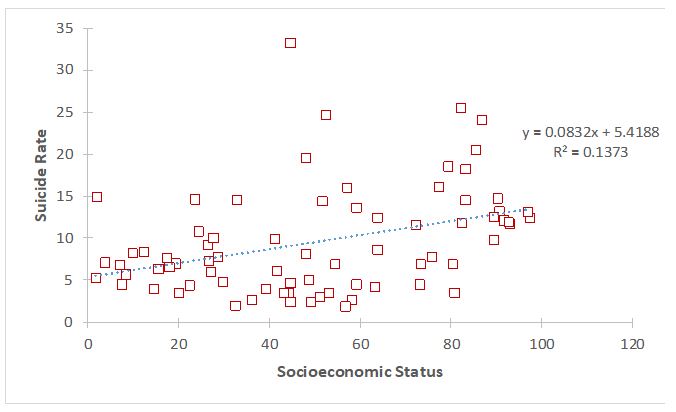Introduction
The hypothesis was postulated that there is a strong correlation between suicide rate (SR) and low socioeconomic (SES). Specifically, based on a cursory literature review, it was hypothesized that when SES falls, there is an increase in the global suicide rate. Two variables were involved in the study: the SES assessed a person’s composite of well-being, wealth, and social status. Generally, the higher an individual’s SES, the higher their position in society and the safer, more comfortable, and happier life they lead. The second variable of the study was the suicide rate: this is also a continuous numerical variable assessing the frequency of suicides committed in the world.
Methodology
Published open data, including average SES and suicide rates by country, were used for this study. Data from Sdorius (2019) was used to collect information on SES among countries, and data from Kanawattanachai (2021) helped to collect information on average SR per country (per 100,000 population). The datasets were generally used to represent geographic and temporal distributions comprehensively.
Both authors consulted comprehensive official datasets, so the published arrays were characterized by reliability and accuracy. Since both arrays contained retrospective data, 2010 was chosen as the starting point – sufficient data on both SES and SR were collected for that year. Data were collected from the two sets; all years except 2010 were removed, as were all countries with incomplete data rows.
Output Data
Figure 1 provides information on the regression equation and coefficient of determination for the dataset of 74 countries in 2010. As can be seen, there is a positive relationship between SES and SR, with SR being able to explain up to 13.73% of the variance of SR. The correlation coefficient was 0.37, indicating a moderate positive relationship. In other words, the 2010 data shows that when SES increases, there is also an increase in SR. This creates a contradiction with the previously stated hypothesis, as it indicates that people with higher SES may be more likely to be suicidal on average.

Conclusion
The study was built on the assumption that when SES increases, there is an increase in suicide rates. After processing, the data was collected from public sources and included 74 data points for 2010. The results of the correlation analysis showed that there was a moderate positive relationship between the variables. This suggests that those with greater SES may be more prone to commit suicide, which runs counter to the study’s hypothesis.
References
Kanawattanachai, P. (2021). Homicide rate, suicide rate and GDP 1970-2020. Kaggle. Web.
Sdorius. (2019). Country socioeconomic status scores, part II. Kaggle. Web.